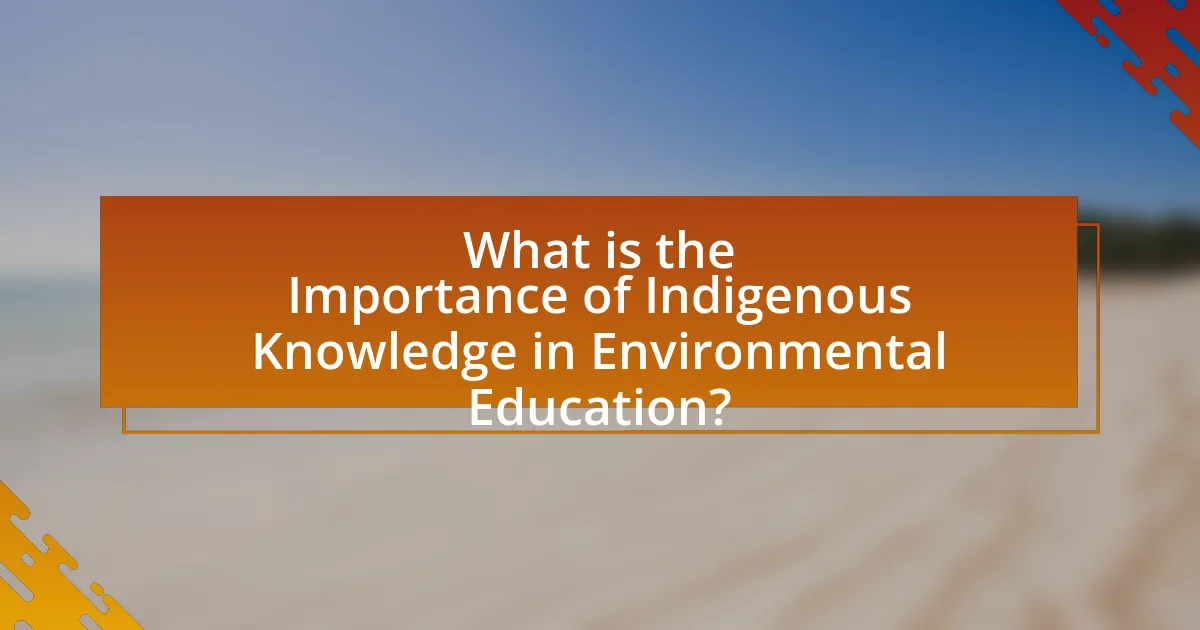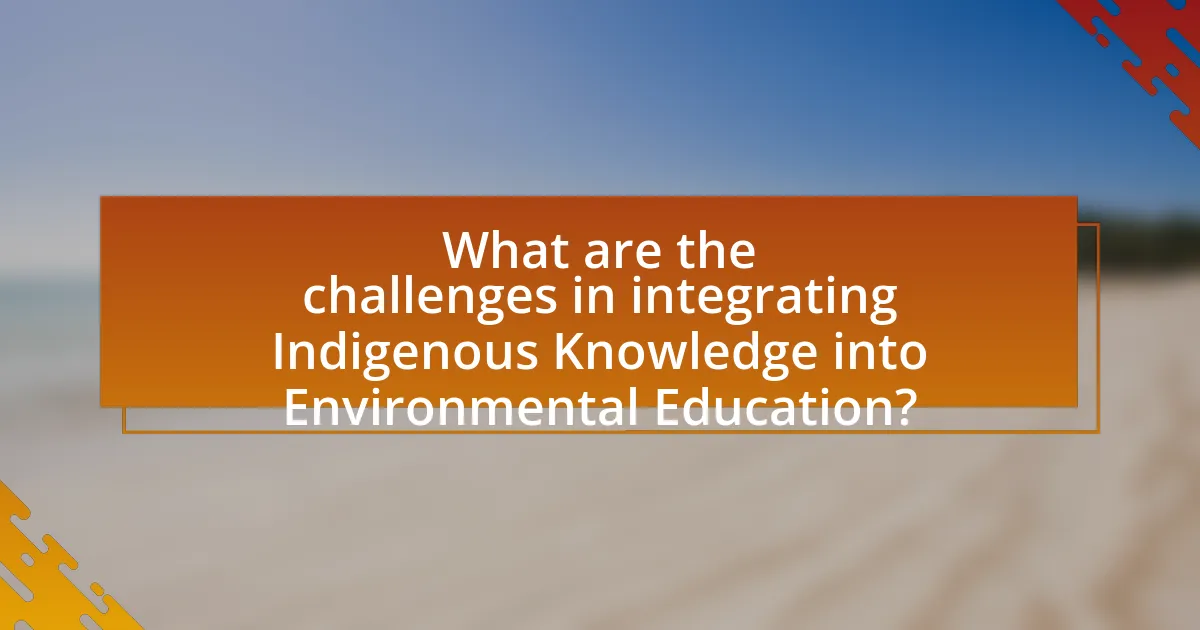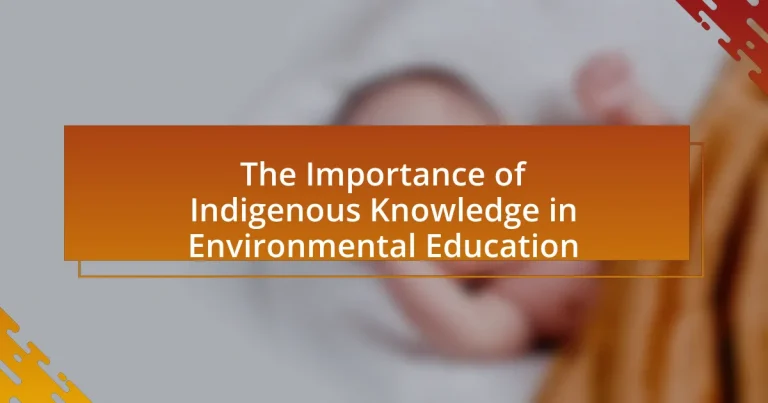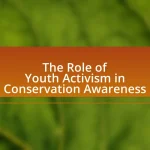The article emphasizes the significance of Indigenous Knowledge in environmental education, highlighting its role in promoting sustainable practices and ecological stewardship developed over generations. It explores how Indigenous perspectives contribute to a deeper understanding of local ecosystems, biodiversity, and resource management techniques, contrasting these holistic approaches with Western scientific methods. The article also addresses the challenges of integrating Indigenous Knowledge into educational systems, including cultural misunderstandings and systemic biases, while outlining practical steps for educators to effectively incorporate Indigenous perspectives into their curricula. Ultimately, it underscores the benefits of Indigenous Knowledge in fostering ecological awareness and enhancing educational outcomes.

What is the Importance of Indigenous Knowledge in Environmental Education?
Indigenous knowledge is crucial in environmental education as it provides unique insights into sustainable practices and ecological stewardship developed over generations. This knowledge encompasses traditional ecological knowledge, which includes understanding local ecosystems, biodiversity, and resource management techniques that have proven effective in maintaining environmental balance. For instance, Indigenous communities often utilize practices such as controlled burns to manage landscapes, which have been shown to reduce wildfire risks and promote biodiversity. Studies indicate that integrating Indigenous knowledge into environmental education enhances the effectiveness of conservation efforts and fosters a deeper connection between communities and their natural environments.
How does Indigenous Knowledge contribute to environmental understanding?
Indigenous Knowledge contributes to environmental understanding by providing insights into sustainable practices and ecological relationships developed over generations. This knowledge encompasses traditional ecological wisdom, which includes understanding local ecosystems, biodiversity, and climate patterns. For instance, Indigenous communities often utilize practices such as controlled burns to manage landscapes, which has been shown to enhance biodiversity and reduce wildfire risks, as evidenced by studies highlighting the effectiveness of these methods in regions like Australia and North America. Furthermore, Indigenous Knowledge emphasizes the interconnectedness of humans and nature, fostering a holistic approach to environmental stewardship that is increasingly recognized in contemporary environmental management strategies.
What are the key principles of Indigenous Knowledge in relation to the environment?
The key principles of Indigenous Knowledge in relation to the environment include a deep understanding of ecological relationships, sustainability, and the interconnectedness of all living beings. Indigenous Knowledge emphasizes the importance of observing and respecting natural cycles, which has been practiced for thousands of years, as seen in traditional land management techniques that promote biodiversity and ecosystem health. This knowledge is often passed down through generations, highlighting the significance of oral traditions and community involvement in environmental stewardship. For instance, Indigenous fire management practices have been shown to reduce wildfire risks and enhance habitat diversity, demonstrating the effectiveness of these principles in contemporary environmental challenges.
How does Indigenous Knowledge differ from Western scientific approaches?
Indigenous Knowledge differs from Western scientific approaches primarily in its holistic and experiential nature, emphasizing relationships with the environment rather than isolated phenomena. Indigenous Knowledge is rooted in cultural traditions, oral histories, and community practices, which inform sustainable practices and ecological stewardship over generations. In contrast, Western scientific approaches often prioritize empirical data, experimentation, and quantifiable results, focusing on individual components of ecosystems rather than their interconnectedness. This distinction is evident in environmental management strategies; for example, Indigenous practices often incorporate seasonal cycles and local biodiversity, while Western methods may rely on standardized models that do not account for local ecological nuances.
Why is Indigenous Knowledge essential for sustainable practices?
Indigenous Knowledge is essential for sustainable practices because it encompasses a deep understanding of local ecosystems, biodiversity, and sustainable resource management developed over generations. This knowledge is rooted in the cultural and spiritual connections Indigenous peoples have with their land, which informs practices that promote ecological balance and resilience. For instance, Indigenous fire management techniques, such as controlled burns, have been shown to reduce wildfire risks and enhance biodiversity, as documented in studies like “Cultural Burning: A Key to Sustainable Land Management” by the University of California. Such practices illustrate how Indigenous Knowledge contributes to sustainable environmental stewardship, making it a vital component in addressing contemporary ecological challenges.
What role does Indigenous Knowledge play in biodiversity conservation?
Indigenous Knowledge plays a crucial role in biodiversity conservation by providing insights into sustainable practices and ecological relationships developed over generations. This knowledge encompasses traditional ecological knowledge, which includes understanding local ecosystems, species interactions, and resource management techniques that have proven effective in maintaining biodiversity. For instance, Indigenous communities often utilize practices such as controlled burns to manage landscapes, which can enhance habitat diversity and promote species resilience. Studies have shown that areas managed by Indigenous peoples often exhibit higher biodiversity levels compared to those without such management, highlighting the effectiveness of Indigenous Knowledge in fostering ecological health.
How can Indigenous practices enhance climate resilience?
Indigenous practices enhance climate resilience by integrating traditional ecological knowledge with sustainable land management techniques. These practices, such as controlled burns and crop diversification, have been used for centuries to maintain biodiversity and adapt to changing environmental conditions. For instance, Indigenous fire management techniques in Australia have been shown to reduce the risk of catastrophic wildfires while promoting the growth of native vegetation, which supports ecosystem health. Additionally, Indigenous communities often possess a deep understanding of local ecosystems, enabling them to implement adaptive strategies that respond effectively to climate variability. This knowledge is increasingly recognized as vital for developing resilient agricultural systems and conserving natural resources in the face of climate change.

What are the challenges in integrating Indigenous Knowledge into Environmental Education?
Integrating Indigenous Knowledge into Environmental Education faces several challenges, primarily due to differing worldviews and epistemologies. Indigenous Knowledge often emphasizes holistic and relational understandings of the environment, which can conflict with the reductionist approaches commonly found in Western education systems. Additionally, there is a lack of recognition and respect for Indigenous Knowledge within formal educational frameworks, leading to underrepresentation in curricula.
Furthermore, the historical marginalization of Indigenous peoples has resulted in a mistrust of educational institutions, making collaboration difficult. Research indicates that successful integration requires meaningful partnerships with Indigenous communities, yet these relationships can be hindered by bureaucratic barriers and a lack of resources. For instance, a study by the United Nations Educational, Scientific and Cultural Organization (UNESCO) highlights that without adequate support and commitment from educational authorities, the incorporation of Indigenous perspectives remains superficial and ineffective.
What barriers exist in recognizing Indigenous Knowledge within educational systems?
Barriers in recognizing Indigenous Knowledge within educational systems include systemic biases, lack of representation, and insufficient curriculum integration. Systemic biases often stem from a Eurocentric perspective that prioritizes Western scientific methods over Indigenous ways of knowing. This bias can lead to the marginalization of Indigenous voices in educational content. Additionally, the lack of representation of Indigenous educators and scholars in teaching roles contributes to the underrepresentation of Indigenous Knowledge in curricula. Furthermore, many educational systems do not adequately integrate Indigenous perspectives into their programs, resulting in a failure to acknowledge the value of Indigenous ecological practices and philosophies. These barriers hinder the effective incorporation of Indigenous Knowledge into environmental education, limiting students’ understanding of diverse ecological perspectives.
How do cultural misunderstandings impact the integration of Indigenous Knowledge?
Cultural misunderstandings significantly hinder the integration of Indigenous Knowledge by creating barriers to effective communication and collaboration. These misunderstandings often stem from differing worldviews, values, and practices between Indigenous communities and external entities, such as educational institutions or governmental organizations. For instance, Indigenous Knowledge systems are often holistic and place-based, emphasizing relationships with the land, while Western approaches may prioritize empirical data and individualism. This disconnect can lead to misinterpretations of Indigenous practices and a lack of respect for their methodologies. Research indicates that when Indigenous Knowledge is not understood or valued, it can result in the exclusion of Indigenous voices in environmental decision-making processes, ultimately undermining the effectiveness of conservation efforts and educational initiatives.
What legal and political challenges affect the inclusion of Indigenous perspectives?
Legal and political challenges affecting the inclusion of Indigenous perspectives include inadequate legal recognition of Indigenous rights and systemic barriers within governmental structures. Indigenous communities often face difficulties in asserting their rights due to laws that do not fully acknowledge their sovereignty or land claims, as seen in cases like the United Nations Declaration on the Rights of Indigenous Peoples, which, despite being adopted, is not universally implemented. Additionally, political representation is often limited, resulting in a lack of voice in decision-making processes that impact their lands and resources. This marginalization is further compounded by historical injustices and ongoing discrimination, which hinder meaningful engagement and collaboration in environmental education initiatives.
How can educators effectively incorporate Indigenous Knowledge into their curricula?
Educators can effectively incorporate Indigenous Knowledge into their curricula by collaborating with Indigenous communities to ensure authentic representation and understanding. This collaboration allows educators to integrate traditional ecological knowledge, cultural practices, and local histories into lessons, fostering a more holistic view of environmental education. For instance, research by the National Congress of American Indians highlights that Indigenous Knowledge systems emphasize sustainability and stewardship, which can enhance students’ understanding of ecological principles. By utilizing resources such as Indigenous-led workshops and community engagement, educators can create a curriculum that respects and reflects Indigenous perspectives, ultimately enriching the educational experience for all students.
What strategies can be employed to respect and honor Indigenous perspectives?
To respect and honor Indigenous perspectives, educational institutions and organizations can implement collaborative partnerships with Indigenous communities. These partnerships should involve co-developing curricula that integrate Indigenous knowledge systems, ensuring that Indigenous voices are central in the educational process. For example, the incorporation of traditional ecological knowledge (TEK) into environmental education programs has been shown to enhance understanding of local ecosystems and promote sustainable practices. Research indicates that TEK provides valuable insights into biodiversity conservation and resource management, as evidenced by studies conducted by the United Nations Educational, Scientific and Cultural Organization (UNESCO) highlighting the effectiveness of Indigenous methodologies in environmental stewardship.
How can collaboration with Indigenous communities enhance educational outcomes?
Collaboration with Indigenous communities can enhance educational outcomes by integrating traditional ecological knowledge into curricula, which fosters a deeper understanding of environmental stewardship. Research indicates that when educational programs incorporate Indigenous perspectives, students demonstrate improved engagement and retention of information. For instance, a study published in the Journal of Environmental Education found that students exposed to Indigenous knowledge systems showed a 30% increase in their understanding of local ecosystems compared to those who received conventional education. This integration not only enriches the learning experience but also promotes cultural respect and awareness among students, leading to more holistic educational outcomes.

What are the benefits of incorporating Indigenous Knowledge in Environmental Education?
Incorporating Indigenous Knowledge in Environmental Education enhances ecological understanding and promotes sustainable practices. This knowledge, rooted in centuries of experience and observation, provides insights into local ecosystems, biodiversity, and resource management. For instance, Indigenous practices such as controlled burns have been shown to reduce wildfire risks and improve habitat health, as evidenced by studies highlighting the effectiveness of traditional ecological knowledge in land management. Furthermore, integrating Indigenous perspectives fosters cultural respect and inclusivity, enriching educational experiences and encouraging diverse viewpoints on environmental stewardship.
How does Indigenous Knowledge enrich environmental curricula?
Indigenous Knowledge enriches environmental curricula by integrating traditional ecological wisdom, which enhances understanding of local ecosystems and sustainable practices. This knowledge, passed down through generations, includes insights on biodiversity, land management, and resource conservation that are often overlooked in conventional education. For instance, Indigenous practices such as controlled burns have been shown to promote healthy ecosystems and reduce wildfire risks, as evidenced by studies highlighting their effectiveness in maintaining biodiversity and preventing larger fires. By incorporating Indigenous Knowledge, environmental curricula become more holistic, culturally relevant, and effective in addressing contemporary environmental challenges.
What unique insights does Indigenous Knowledge provide for ecological stewardship?
Indigenous Knowledge offers unique insights for ecological stewardship by emphasizing a holistic understanding of ecosystems and sustainable practices developed over generations. This knowledge includes intricate relationships between species, seasonal cycles, and land management techniques that promote biodiversity and resilience. For instance, Indigenous fire management practices, such as controlled burns, have been shown to reduce wildfire risks and enhance habitat diversity, as documented in studies like “Cultural Burning: A Key to Ecological Stewardship” by the University of California. These practices illustrate how Indigenous perspectives can inform modern ecological strategies, leading to more effective stewardship of natural resources.
How can Indigenous Knowledge foster a sense of place and belonging in students?
Indigenous Knowledge fosters a sense of place and belonging in students by connecting them to their cultural heritage and the natural environment. This knowledge encompasses traditional practices, stories, and ecological understandings that are specific to local landscapes, which helps students develop a personal and communal identity tied to their surroundings. For instance, research by the University of Alberta highlights that integrating Indigenous perspectives in education enhances students’ emotional and social connections to their communities, leading to improved well-being and academic success. By engaging with Indigenous Knowledge, students not only learn about their environment but also cultivate respect for their cultural roots, thereby reinforcing their sense of belonging.
What practical steps can educators take to implement Indigenous Knowledge in their teaching?
Educators can implement Indigenous Knowledge in their teaching by integrating local Indigenous perspectives and practices into the curriculum. This can be achieved through collaboration with Indigenous communities to co-create educational materials that reflect their knowledge systems, such as traditional ecological knowledge, which emphasizes sustainable practices and respect for the environment. Research shows that incorporating Indigenous perspectives enhances students’ understanding of environmental issues, as evidenced by studies like “Indigenous Knowledge in Environmental Education” by Cajete (1994), which highlights the effectiveness of Indigenous methodologies in fostering ecological awareness. Additionally, educators can invite Indigenous speakers to share their experiences and knowledge, thereby enriching the learning environment and promoting cultural understanding.
How can educators build partnerships with Indigenous communities?
Educators can build partnerships with Indigenous communities by actively engaging in respectful dialogue and collaboration. This involves recognizing and valuing Indigenous knowledge systems, which are essential for environmental education. For instance, educators can invite Indigenous leaders and knowledge holders to participate in curriculum development, ensuring that Indigenous perspectives are integrated into educational programs. Research shows that such collaborations enhance students’ understanding of ecological practices and cultural heritage, as demonstrated in studies like “Indigenous Knowledge in Environmental Education” by the University of Alberta, which highlights the positive impact of Indigenous partnerships on student learning outcomes.
What resources are available for educators to learn about Indigenous Knowledge?
Educators can access a variety of resources to learn about Indigenous Knowledge, including online courses, academic journals, and community workshops. For instance, the University of Alberta offers a course titled “Indigenous Perspectives on Environmental Education,” which provides insights into Indigenous worldviews and practices. Additionally, the journal “Decolonization: Indigeneity, Education & Society” publishes research articles that explore Indigenous Knowledge in educational contexts. Community organizations, such as the National Indian Education Association, also provide workshops and resources aimed at integrating Indigenous perspectives into curricula. These resources are essential for educators seeking to incorporate Indigenous Knowledge into their teaching practices effectively.


